 Facebook
Facebook
 X
X
 Instagram
Instagram
 TikTok
TikTok
 Youtube
Youtube
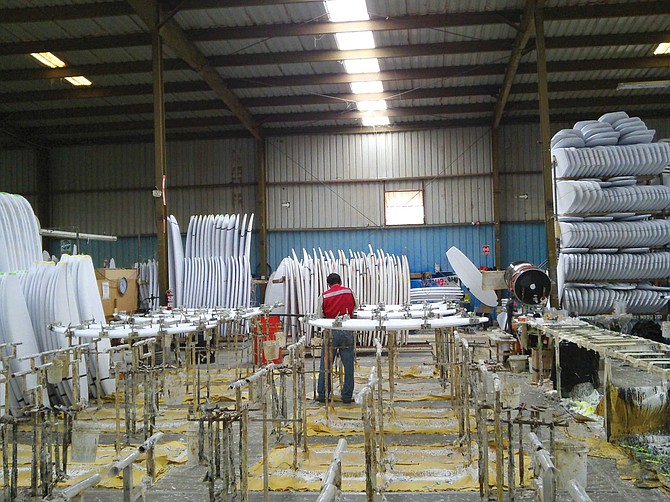
The Baja Peninsula is a Rorschach test. Visitors see heaven or hell in an arid landscape. Three million-plus citizens see a homeland free of the congestion of their northern neighbors. Surfers see a crooked finger pointing out a 760-mile long point break. While this wild-western wave garden is a stone’s throw from San Diego and is being tamed by ever more roads and regulations, it possesses enough raw roaring nature to offer adventurers the best day of their lives. Or the worst. The road to surftopia is fraught with sorrow — or, at a minimum, uncertainty. But survive the pavement-hogging 18-wheelers, flash floods, bandits, cartels, and Federales, and you have decent odds of scoring the best waves of your life.
In the 1950s, California surfers rarely ventured deep into Baja, preferring to stay within a few clicks of their own southern border. They rode what were then secret surf spots with names such as San Miguel, 3-M’s, Stacks, and K-38, all an easy drive from the border. Just as often, however, the bread crumb trail ended at the door of Tijuana’s Long Bar, where famed surfers such as Butch “Mister Pipeline” Van Artsdalen, “Pal” Al Nelson, Pat Curren, and compadres of theirs ruled the roost.

By Sunday afternoon, the party moved to Plaza Monumental de Tijuana, the Tijuana bullring. Fueled by alcohol, adrenaline, and testosterone, the boys mentioned above, along with a handful of other Southern California wave riders, paid their admission and took their seats in the stands. Good behavior was checked at the ticket counter, however, as the teenagers abandoned whatever remained of their Sunday school manners. These fine young savages were less concerned with the raging bull being sacrificed for their pleasure than with the elegance displayed by the matador who pirouetted near deadly horns. The grace-under-pressure poses would leave a mark on their souls.
One Orange County surfer to frequent the Plaza was named Steve Pezman. “Pez” would settle down with wife, kids, and a surf magazine career that spanned 50 years and culminated in launching and running what many regard as the best surf publication of all time, The Surfer’s Journal. Back then, however, he was just another surf brat, unable to free himself from the shackles of desire and disaster.
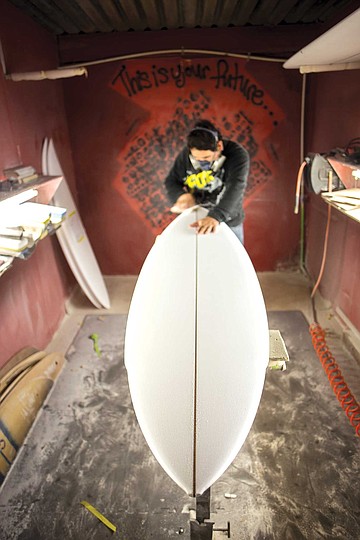
One afternoon at the bullring, Pez thought it wise to huck a watermelon at the matador, Luis Procuna. In hindsight, it was fortunate that the boy was arrested and taken to the Tijuana jail since the crowd, who adored the matador, might have preferred throwing the adolescent to the bulls. “Years later,” according to Pez, “My friend [Bob] Beadle was attending a party in Beverly Hills where the guest of honor was Procuna. When asked about his worst moment in the ring, you guessed it!”
Most took the safe route home after the bullfights. One of Pezman’s friends, however, a surfer named Bud Hedrick, was so smitten by the matches that he moved to Spain and became a matador. According to Pezman, “Bud began on the B-circuit as a serious matador in something that resembled a combination bullfight and traveling circus. Eventually, however, he rose through the ranks to fight in major bullrings. There are photos of him arching [in something now considered surfer style] with the bull sweeping by.”
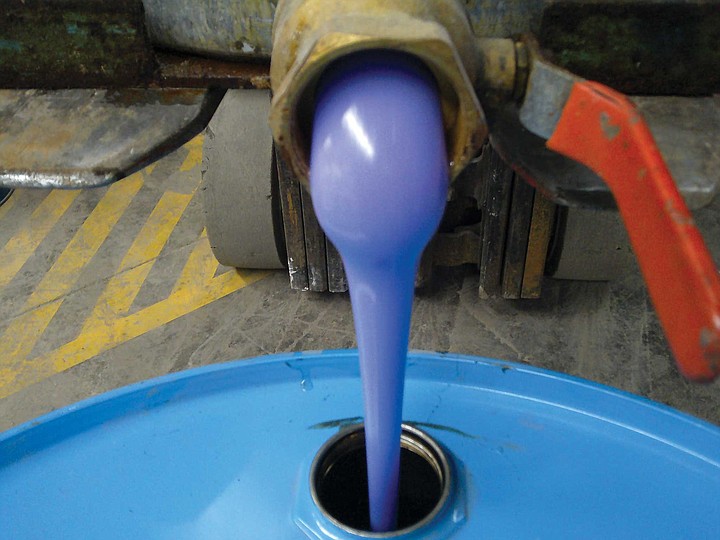
Around the same time (the early ‘60s), famous surfer Joey Cabell faced a charging bull once or twice. Most, however, stayed behind the wall, in the stands. To my knowledge, 1958 U.S. Surfing Champion, the late “Captain” Jack Haley never did enter the ring, but he possessed the presence of mind to observe something most others missed. Again, according to Pezman, “Haley and his crew frequented the bullring, all the while noting the sameness of the dances between surfing and bullfighting. But besides the physical dynamics of avoiding the charging bull with feet set, and doing the same in surfing to avoid the curl line, I see no basis for one influencing the other.”
Hedrick has a slightly different take. “From the ‘50s on, surfers have identified with the matador, both taking risks in a graceful way. When I returned home from Spain to California after two years, I noticed a change in surfing style among bullring aficionados. Not that they copied matador’s maneuvers; they merely assumed the stylish stance, something they hadn’t done before. When you see photos of Phil Edwards [considered among the world’s best surfers in the ‘50s and early ‘60s], you notice the arched back with chest forward, standing upright with an elegant posture. Times have changed, and that style is seldom seen now. Surfers are riding bigger and faster waves than ever before, and there is a need for them to remain in a crouched position.”
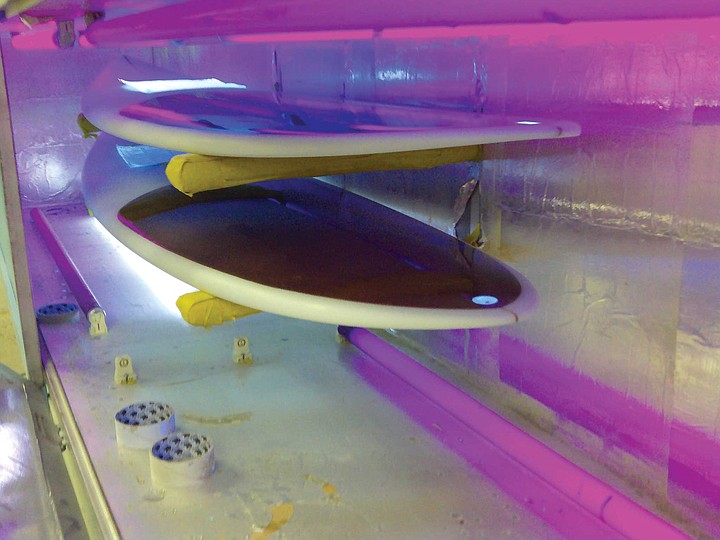
By the mid-‘60s surfing had adopted the peace/love values of that era, and its practitioners no longer visited the bullring. From then to now, Tijuana was a skipping stone en route to the epic surf further south.
Few of those who risk 18-wheelers, bandits, cartels, Federales know much about Mexican surf culture. For instance, they have no idea that the board they are riding may have had its origins within spitting distance of a Hussong’s barstool.
Anyone receiving their information about Baja surfing from the surf media can be forgiven this oversight. These outlets offer scant documentation that Mexican surfers exist or build surfboards. Sponsored pros pour in from the States, cross the border on the company’s dime, hang in luxury hotels, and appear in videos and online surf publications without a shot being published of a local surfer. Because of their five-star isolation, few visiting pros have contact with local wave riders.
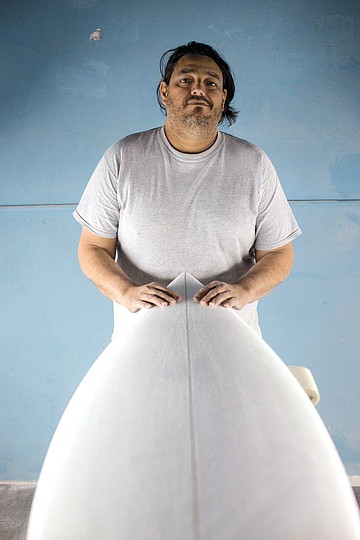
Credited as one of Baja’s first surfers, Ignacio Felix Cota has attempted to educate people about his homeland’s connection to surfing with his book Tribe of the Waves: Memories of Mexican Surfing. In it, he chronicles Mexico’s legendary surf spots and those who rode them. Nearly unknown in the U.S., Arturo Monroy, Rodrigo Huerta, Juan Garcia, Luis Skeen, Alfonso Polidura, and Felix himself are as celebrated among Baja surfers as Rabbit Kekai and Phil Edwards are in Hawaii and California.
Felix grew up in Ensenada in the early ‘60s, when it was a tiny outpost on the edge of a desert. As the first Mexican member of the WindanSea Surf Club, he led the initial charge to Todos Santos Island, where waves often hit triple the height of those on the mainland, due to the island’s submarine canyon.
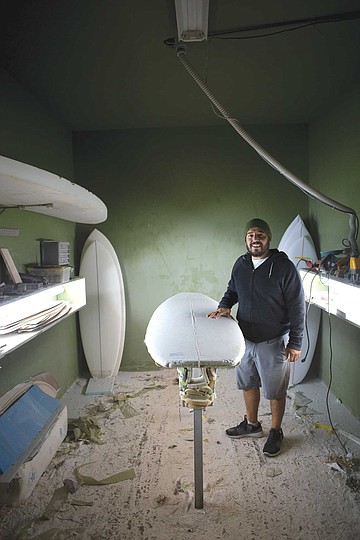
Since those days, the population of Ensenada has swelled beyond half a million, with a body count exceeding that on weekends and holidays. Still, perhaps because it is bordered to east and south by vacant land or sparsely populated settlements, and to the west by the Pacific Ocean, Ensenada retains a small-town vibe.
The harbor serves as the city’s center, and the launch pad to Todos Santos Island, where the surf break “Killers” will test the most seasoned veteran. Ensenada’s fish canneries, tire factories, seedy and first-class bars, street taco vendors, gourmet restaurants, women’s boutiques, and red-light district harmonize to the music, which is mainly Mariachi.
Those seeking the 20-foot-plus thrill ride of a Killer’s drop are not distracted by the carnival atmosphere of the city, but focused instead on the 22-foot panga that will take them eight miles west to a risky surf nirvana. While it is flat much of the year, Killer’s is awakened each winter when north swells pour in from the Aleutian Islands.
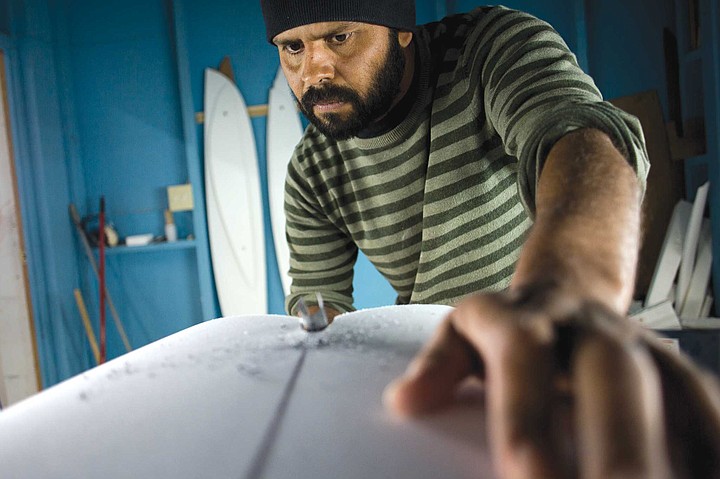
Now, approaching 70 years old, big-wave pioneer and surfboard builder Gary Linden continues to charge into whatever Todos can throw at him. But Linden visits Ensenada for reasons beyond big waves — he does business there, sometimes shaping his brand of Linden Surfboards and employing board builders on either side of the border.
Building a surfboard in Ensenada often begins at the Arctic Foam factory. There, up to 400 blanks (the wooden-braced foam slabs that compose the cores of surfboards) are made under the supervision of one of the company’s three owners: Marty Gilchrist, who is my tour guide today. Arctic resembles an airplane factory in a black-and-white WWII newsreel. Everyone and everything moves like polished pieces of a gigantic machine. The final result is a snow-white polyurethane blank with the crunch of a dense Ritz Cracker.
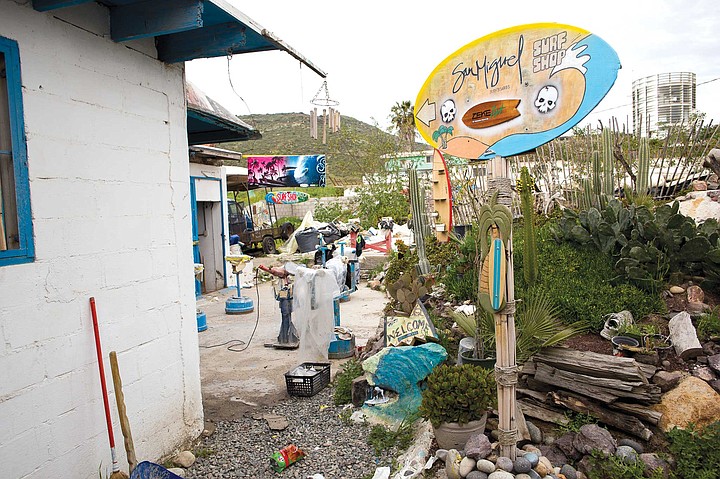
Gilchrist: “I first did business in Ensenada when I worked for Rip Curl, [the famous Australian wetsuit manufacturer] and we had some of our suits made here.”
Knowing the region, the landlords, and the advantage of reasonable rent made Ensenada a natural home base for Arctic Foam when they stepped into the foam game four years ago.
Besides making foam, Arctic builds complete surfboards in the upstairs portion of their factory. Once a blank is shaped, it is moved to the glass shop. There, ultraviolet curing resin is applied to the fiberglass cloth, which has been cut and draped over the shaped blank. Once the resin is sufficiently hard, the board is flipped, the lap line cut and the opposite side undergoes the same process. From there, another pour of resin called a hot coat covers both sides of the laminated board. Fin boxes and a leash plug are routed in, and the board is sanded, glossed, and polished to a mirror finish. The entire process requires about ten hours of hand labor and nearly as much time for the resin to dry.

Arctic employee Abraham Teran has been glassing surfboards for over 30 of his 47 years. Teran is a rarity in the surf industry, in that he does not surf. According to him, “I am always worried how a board will work, so I do my best at every step. I know there’s always room for improvement, but I am not trying to be better than anyone else; I am trying to be better than me.”
The plan is for Gilchrist to escort me to some of the main surfboard factories in Ensenada. We are about to depart for our mission when Marty is approached by the man in charge of Arctic’s Mexican sales, big-wave rider and Todos Santo regular Vicente Yazbek. Plans change after Yazbek mentions that one of the company’s shaping machines has broken down. Before jumping in to solve the problem, Gilchrist requests that one of his main shapers, Mario Medel. escort me to meet the other board builders.
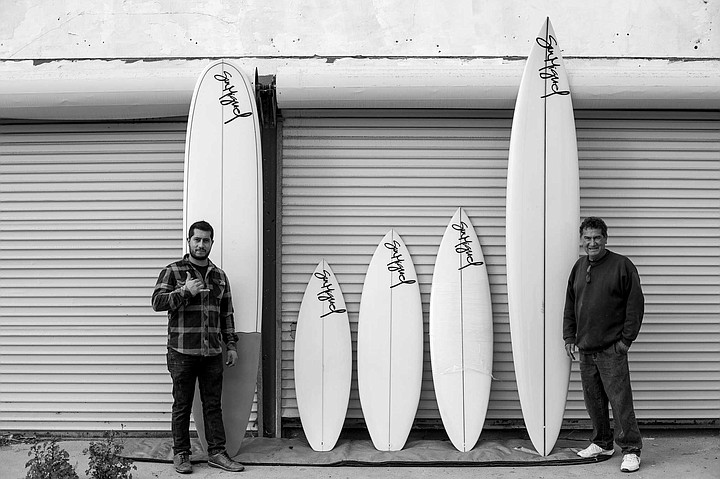
Medel agrees, drives me to the northern outskirts of town and introduces me to Edwardo “Chega” Chegaray. Chega is the unofficial godfather of Ensenada surfboard builders and is regarded as surf royalty. Even competitive manufacturers such as Medel and Teran speak highly of Chega and credit him with teaching them much of what they know about the surfboard industry. Like many other board builders in town, Chega glasses boards for some U.S. brands while concentrating on his own label, San Miguel, a name lifted from one of Northern Baja’s most famous surf spots.
Chega began surfing in 1968 under the instruction of Marc Jeffroy, the uncle of famed U.S. surfer J-P de Kervor, who enjoys dual citizenship and is therefore eligible to compete in the Mexican National Championships, an event he once won in the 45-and-over division.
Chega began making boards around the same time he started surfing. Starting in his parent’s garage, he did what many backyard board builders did in those days, peeling the glass from old longboards, cutting them down, reshaping them, glassing them again, and taking his first steps in a long apprenticeship.
Alternately known as “Mister Barrel,” Chega was widely considered Mexico’s best surfer by the late 1970s. He remained active as a waterman until a heart attack 15 years ago slowed him down both in and out of the water. It was then his son, who is affectionately introduced to me by his father as “Chega Junior,” quit a well-paying engineering job in Tijuana to help with the family business.
In the ‘80s, Chega took a year off and honored surfing’s tradition of seeking out uncharted breaks. After driving to Cabo, where he found undiscovered surf spots, he rode the ferry south to mainland Mexico, and he and a few friends encountered perfect and empty surf in warm water. Agony followed ecstasy, however, when his close friend Evencio Garcia, one of Mexico’s top surfers, disappeared in a freak surfing accident in the early 1980s. According to Chega, “Evencio was surfing near Acapulco, and on his last wave, he did an aerial. When he fell on the landing, he didn’t come up, and his body was never found.”
Adjacent to the San Miguel Surfboard factory is a sign reading “Zeké Art.” Here, dozens of dinged and broken boards await repair, some after being snapped in two by Baja’s fiercest waves. Because of his numerous successful surgeries performed on surfboards, Zeké is known as “The Doctor.” But the doctor is not in.
Mario Medel echoes the thoughts of many of his contemporaries when he says, “ I make a good enough living here in the surfboard industry so that I don’t have to go to the U.S. to work. We all have visas and can cross the border whenever we like, but we prefer to live and work here.”
When not manufacturing his own “Mars Surfboards,” Medel is a finish shaper for Arctic Foam, where he completes up to 50 boards week. Among the youngest of Ensenada’s board builders, Medel is, according to Gilchrist, “An excellent shaper well on his way to becoming one of the top board builders in town.”
Like all the shapers I spoke to, Mario began building surfboards at home, where he basically taught himself every facet in the art of making surfboards from scratch.
Last year, Medel joined a group of Ensenada surfers on the North Shore of Oahu. It was there he met with one of surfing ‘s most celebrated board designers, John Pyzel, the shaper for Hawaii-raised World Surfing Champion John John Florence. While trips like this are rare for this Ensenada surf crew, they savor all aspects of it, enjoying the exchange with other board makers almost as much as they do the exotic waves themselves.
Rodrigo Orozco began building boards 33 years ago, at age 13. As indicated previously, there were few local surfers in Ensenada at the time, and it wasn’t until he was on vacation with his family in San Diego that he noticed anyone riding waves. According to him, “After that, I had to learn to surf. Once I did, my friends and I would go surfing all day with no money for anything but gas, chips, and sodas.”
Like every board builder in this article, Rodrigo has his own label, Orozco Surfboards. And like all the others, he works for some noteworthy U.S. board makers. Tim Bessell, owner of California-based Bessell Surfboards, is among Orozco’s clients. Bessell is extremely particular about who glasses his boards; some of his boards sell for many times the price of other handmade surfboards. While his standard surfboards are in high demand for their quality and riding characteristics, the reason for the price jump in special cases is that Bessell holds a license from artists Jackson Pollack, Kenny Scharf, and others to decorate his boards with their images. These limited edition art pieces can fetch up to $40,000.
Orozco’s surfboard factory was once used by his family to make Huarache Sandals. Huaraches in the early ‘60s were popular among California surfers. In the Beach Boys' “Surfin’ USA” they sing, “You’ll see ‘em wearin’ their baggies, huarache sandals too…”
Jorge Boycé learned to surf and make surfboards in the mainland Mexican town of San Blas, where his grandfather owned a restaurant on Matanchen Bay. According to Boycé, “A lot of American surfers left their boards at his restaurant so that when they returned the next year, they had something to ride. I wanted to use them, but my grandfather wouldn’t even let me touch them.”
But when the surfing bug bit Boycé, Jorge was determined to learn surfing.
There’s a dumb ritual observed by some surfers where, after shots of tequila or other libations, they burn a surfboard as a mock offering to an unnamed god in the pretend hopes that this will bring the surf up. Boycé was grateful for the practice. “Once the fire went out, I would peel the burned glass from the blank and wash the cloth. I would then glass whatever blank I could find with the burnt glass. The board was weak, but it somehow worked. Eventually, I began getting glass, resin, and blanks from the States. Even then, I made my first 51 boards without power tools, even sanding them by hand.”
Boycé shares a facility with Ricardo Garcia, owner of Garcia Surfboards. Garcia, who has a B.A. in marine science, applies his knowledge to the hydrodynamics involved in surfboards. He began in the business doing ding repairs at around age 10. Now, 34, he started building surfboards full time in 2002.
Garcia loves making custom surfboards, and cares little for production work. “It would kill me to make the same exact board day after day.” Garcia's orders are nearly exclusively custom. About 85 percent of them go to local Ensenada surfers.
“My dad had been a surfer when he was young, and one of his surfboards hung over my bed. I would look up at that board every night, and think about riding it and building one like it.”
After a day talking with board builders, I find Marty Gilchrist back at Arctic Foam, relieved that his shaping machine is fixed and ecstatic that he is one step nearer to his dream of creating biodegradable surf blanks. The quest has led Gilchrist and team on a three-year journey to make blanks from algae and other earth-friendly ingredients. “After the tests we did today, we are really close to offering this new foam to the public,” said Gilchrist. “A lot of people think we moved to Baja because the environmental regulations aren’t as strict here as they are in the States. It’s just the opposite. The government requires that we account for all our waste and recycle as much as possible. We pay about $3000 to assure we are in compliance.”
This year at the Arctic Foam Christmas Party, Gilchrist overheard a conversation among some employees. “They weren’t talking about the food, where they were going on vacation, or even the waves, but how they wanted to make better surfboards.”


The Baja Peninsula is a Rorschach test. Visitors see heaven or hell in an arid landscape. Three million-plus citizens see a homeland free of the congestion of their northern neighbors. Surfers see a crooked finger pointing out a 760-mile long point break. While this wild-western wave garden is a stone’s throw from San Diego and is being tamed by ever more roads and regulations, it possesses enough raw roaring nature to offer adventurers the best day of their lives. Or the worst. The road to surftopia is fraught with sorrow — or, at a minimum, uncertainty. But survive the pavement-hogging 18-wheelers, flash floods, bandits, cartels, and Federales, and you have decent odds of scoring the best waves of your life.
In the 1950s, California surfers rarely ventured deep into Baja, preferring to stay within a few clicks of their own southern border. They rode what were then secret surf spots with names such as San Miguel, 3-M’s, Stacks, and K-38, all an easy drive from the border. Just as often, however, the bread crumb trail ended at the door of Tijuana’s Long Bar, where famed surfers such as Butch “Mister Pipeline” Van Artsdalen, “Pal” Al Nelson, Pat Curren, and compadres of theirs ruled the roost.

By Sunday afternoon, the party moved to Plaza Monumental de Tijuana, the Tijuana bullring. Fueled by alcohol, adrenaline, and testosterone, the boys mentioned above, along with a handful of other Southern California wave riders, paid their admission and took their seats in the stands. Good behavior was checked at the ticket counter, however, as the teenagers abandoned whatever remained of their Sunday school manners. These fine young savages were less concerned with the raging bull being sacrificed for their pleasure than with the elegance displayed by the matador who pirouetted near deadly horns. The grace-under-pressure poses would leave a mark on their souls.
One Orange County surfer to frequent the Plaza was named Steve Pezman. “Pez” would settle down with wife, kids, and a surf magazine career that spanned 50 years and culminated in launching and running what many regard as the best surf publication of all time, The Surfer’s Journal. Back then, however, he was just another surf brat, unable to free himself from the shackles of desire and disaster.

One afternoon at the bullring, Pez thought it wise to huck a watermelon at the matador, Luis Procuna. In hindsight, it was fortunate that the boy was arrested and taken to the Tijuana jail since the crowd, who adored the matador, might have preferred throwing the adolescent to the bulls. “Years later,” according to Pez, “My friend [Bob] Beadle was attending a party in Beverly Hills where the guest of honor was Procuna. When asked about his worst moment in the ring, you guessed it!”
Most took the safe route home after the bullfights. One of Pezman’s friends, however, a surfer named Bud Hedrick, was so smitten by the matches that he moved to Spain and became a matador. According to Pezman, “Bud began on the B-circuit as a serious matador in something that resembled a combination bullfight and traveling circus. Eventually, however, he rose through the ranks to fight in major bullrings. There are photos of him arching [in something now considered surfer style] with the bull sweeping by.”

Around the same time (the early ‘60s), famous surfer Joey Cabell faced a charging bull once or twice. Most, however, stayed behind the wall, in the stands. To my knowledge, 1958 U.S. Surfing Champion, the late “Captain” Jack Haley never did enter the ring, but he possessed the presence of mind to observe something most others missed. Again, according to Pezman, “Haley and his crew frequented the bullring, all the while noting the sameness of the dances between surfing and bullfighting. But besides the physical dynamics of avoiding the charging bull with feet set, and doing the same in surfing to avoid the curl line, I see no basis for one influencing the other.”
Hedrick has a slightly different take. “From the ‘50s on, surfers have identified with the matador, both taking risks in a graceful way. When I returned home from Spain to California after two years, I noticed a change in surfing style among bullring aficionados. Not that they copied matador’s maneuvers; they merely assumed the stylish stance, something they hadn’t done before. When you see photos of Phil Edwards [considered among the world’s best surfers in the ‘50s and early ‘60s], you notice the arched back with chest forward, standing upright with an elegant posture. Times have changed, and that style is seldom seen now. Surfers are riding bigger and faster waves than ever before, and there is a need for them to remain in a crouched position.”

By the mid-‘60s surfing had adopted the peace/love values of that era, and its practitioners no longer visited the bullring. From then to now, Tijuana was a skipping stone en route to the epic surf further south.
Few of those who risk 18-wheelers, bandits, cartels, Federales know much about Mexican surf culture. For instance, they have no idea that the board they are riding may have had its origins within spitting distance of a Hussong’s barstool.
Anyone receiving their information about Baja surfing from the surf media can be forgiven this oversight. These outlets offer scant documentation that Mexican surfers exist or build surfboards. Sponsored pros pour in from the States, cross the border on the company’s dime, hang in luxury hotels, and appear in videos and online surf publications without a shot being published of a local surfer. Because of their five-star isolation, few visiting pros have contact with local wave riders.

Credited as one of Baja’s first surfers, Ignacio Felix Cota has attempted to educate people about his homeland’s connection to surfing with his book Tribe of the Waves: Memories of Mexican Surfing. In it, he chronicles Mexico’s legendary surf spots and those who rode them. Nearly unknown in the U.S., Arturo Monroy, Rodrigo Huerta, Juan Garcia, Luis Skeen, Alfonso Polidura, and Felix himself are as celebrated among Baja surfers as Rabbit Kekai and Phil Edwards are in Hawaii and California.
Felix grew up in Ensenada in the early ‘60s, when it was a tiny outpost on the edge of a desert. As the first Mexican member of the WindanSea Surf Club, he led the initial charge to Todos Santos Island, where waves often hit triple the height of those on the mainland, due to the island’s submarine canyon.

Since those days, the population of Ensenada has swelled beyond half a million, with a body count exceeding that on weekends and holidays. Still, perhaps because it is bordered to east and south by vacant land or sparsely populated settlements, and to the west by the Pacific Ocean, Ensenada retains a small-town vibe.
The harbor serves as the city’s center, and the launch pad to Todos Santos Island, where the surf break “Killers” will test the most seasoned veteran. Ensenada’s fish canneries, tire factories, seedy and first-class bars, street taco vendors, gourmet restaurants, women’s boutiques, and red-light district harmonize to the music, which is mainly Mariachi.
Those seeking the 20-foot-plus thrill ride of a Killer’s drop are not distracted by the carnival atmosphere of the city, but focused instead on the 22-foot panga that will take them eight miles west to a risky surf nirvana. While it is flat much of the year, Killer’s is awakened each winter when north swells pour in from the Aleutian Islands.

Now, approaching 70 years old, big-wave pioneer and surfboard builder Gary Linden continues to charge into whatever Todos can throw at him. But Linden visits Ensenada for reasons beyond big waves — he does business there, sometimes shaping his brand of Linden Surfboards and employing board builders on either side of the border.
Building a surfboard in Ensenada often begins at the Arctic Foam factory. There, up to 400 blanks (the wooden-braced foam slabs that compose the cores of surfboards) are made under the supervision of one of the company’s three owners: Marty Gilchrist, who is my tour guide today. Arctic resembles an airplane factory in a black-and-white WWII newsreel. Everyone and everything moves like polished pieces of a gigantic machine. The final result is a snow-white polyurethane blank with the crunch of a dense Ritz Cracker.

Gilchrist: “I first did business in Ensenada when I worked for Rip Curl, [the famous Australian wetsuit manufacturer] and we had some of our suits made here.”
Knowing the region, the landlords, and the advantage of reasonable rent made Ensenada a natural home base for Arctic Foam when they stepped into the foam game four years ago.
Besides making foam, Arctic builds complete surfboards in the upstairs portion of their factory. Once a blank is shaped, it is moved to the glass shop. There, ultraviolet curing resin is applied to the fiberglass cloth, which has been cut and draped over the shaped blank. Once the resin is sufficiently hard, the board is flipped, the lap line cut and the opposite side undergoes the same process. From there, another pour of resin called a hot coat covers both sides of the laminated board. Fin boxes and a leash plug are routed in, and the board is sanded, glossed, and polished to a mirror finish. The entire process requires about ten hours of hand labor and nearly as much time for the resin to dry.

Arctic employee Abraham Teran has been glassing surfboards for over 30 of his 47 years. Teran is a rarity in the surf industry, in that he does not surf. According to him, “I am always worried how a board will work, so I do my best at every step. I know there’s always room for improvement, but I am not trying to be better than anyone else; I am trying to be better than me.”
The plan is for Gilchrist to escort me to some of the main surfboard factories in Ensenada. We are about to depart for our mission when Marty is approached by the man in charge of Arctic’s Mexican sales, big-wave rider and Todos Santo regular Vicente Yazbek. Plans change after Yazbek mentions that one of the company’s shaping machines has broken down. Before jumping in to solve the problem, Gilchrist requests that one of his main shapers, Mario Medel. escort me to meet the other board builders.

Medel agrees, drives me to the northern outskirts of town and introduces me to Edwardo “Chega” Chegaray. Chega is the unofficial godfather of Ensenada surfboard builders and is regarded as surf royalty. Even competitive manufacturers such as Medel and Teran speak highly of Chega and credit him with teaching them much of what they know about the surfboard industry. Like many other board builders in town, Chega glasses boards for some U.S. brands while concentrating on his own label, San Miguel, a name lifted from one of Northern Baja’s most famous surf spots.
Chega began surfing in 1968 under the instruction of Marc Jeffroy, the uncle of famed U.S. surfer J-P de Kervor, who enjoys dual citizenship and is therefore eligible to compete in the Mexican National Championships, an event he once won in the 45-and-over division.
Chega began making boards around the same time he started surfing. Starting in his parent’s garage, he did what many backyard board builders did in those days, peeling the glass from old longboards, cutting them down, reshaping them, glassing them again, and taking his first steps in a long apprenticeship.
Alternately known as “Mister Barrel,” Chega was widely considered Mexico’s best surfer by the late 1970s. He remained active as a waterman until a heart attack 15 years ago slowed him down both in and out of the water. It was then his son, who is affectionately introduced to me by his father as “Chega Junior,” quit a well-paying engineering job in Tijuana to help with the family business.
In the ‘80s, Chega took a year off and honored surfing’s tradition of seeking out uncharted breaks. After driving to Cabo, where he found undiscovered surf spots, he rode the ferry south to mainland Mexico, and he and a few friends encountered perfect and empty surf in warm water. Agony followed ecstasy, however, when his close friend Evencio Garcia, one of Mexico’s top surfers, disappeared in a freak surfing accident in the early 1980s. According to Chega, “Evencio was surfing near Acapulco, and on his last wave, he did an aerial. When he fell on the landing, he didn’t come up, and his body was never found.”
Adjacent to the San Miguel Surfboard factory is a sign reading “Zeké Art.” Here, dozens of dinged and broken boards await repair, some after being snapped in two by Baja’s fiercest waves. Because of his numerous successful surgeries performed on surfboards, Zeké is known as “The Doctor.” But the doctor is not in.
Mario Medel echoes the thoughts of many of his contemporaries when he says, “ I make a good enough living here in the surfboard industry so that I don’t have to go to the U.S. to work. We all have visas and can cross the border whenever we like, but we prefer to live and work here.”
When not manufacturing his own “Mars Surfboards,” Medel is a finish shaper for Arctic Foam, where he completes up to 50 boards week. Among the youngest of Ensenada’s board builders, Medel is, according to Gilchrist, “An excellent shaper well on his way to becoming one of the top board builders in town.”
Like all the shapers I spoke to, Mario began building surfboards at home, where he basically taught himself every facet in the art of making surfboards from scratch.
Last year, Medel joined a group of Ensenada surfers on the North Shore of Oahu. It was there he met with one of surfing ‘s most celebrated board designers, John Pyzel, the shaper for Hawaii-raised World Surfing Champion John John Florence. While trips like this are rare for this Ensenada surf crew, they savor all aspects of it, enjoying the exchange with other board makers almost as much as they do the exotic waves themselves.
Rodrigo Orozco began building boards 33 years ago, at age 13. As indicated previously, there were few local surfers in Ensenada at the time, and it wasn’t until he was on vacation with his family in San Diego that he noticed anyone riding waves. According to him, “After that, I had to learn to surf. Once I did, my friends and I would go surfing all day with no money for anything but gas, chips, and sodas.”
Like every board builder in this article, Rodrigo has his own label, Orozco Surfboards. And like all the others, he works for some noteworthy U.S. board makers. Tim Bessell, owner of California-based Bessell Surfboards, is among Orozco’s clients. Bessell is extremely particular about who glasses his boards; some of his boards sell for many times the price of other handmade surfboards. While his standard surfboards are in high demand for their quality and riding characteristics, the reason for the price jump in special cases is that Bessell holds a license from artists Jackson Pollack, Kenny Scharf, and others to decorate his boards with their images. These limited edition art pieces can fetch up to $40,000.
Orozco’s surfboard factory was once used by his family to make Huarache Sandals. Huaraches in the early ‘60s were popular among California surfers. In the Beach Boys' “Surfin’ USA” they sing, “You’ll see ‘em wearin’ their baggies, huarache sandals too…”
Jorge Boycé learned to surf and make surfboards in the mainland Mexican town of San Blas, where his grandfather owned a restaurant on Matanchen Bay. According to Boycé, “A lot of American surfers left their boards at his restaurant so that when they returned the next year, they had something to ride. I wanted to use them, but my grandfather wouldn’t even let me touch them.”
But when the surfing bug bit Boycé, Jorge was determined to learn surfing.
There’s a dumb ritual observed by some surfers where, after shots of tequila or other libations, they burn a surfboard as a mock offering to an unnamed god in the pretend hopes that this will bring the surf up. Boycé was grateful for the practice. “Once the fire went out, I would peel the burned glass from the blank and wash the cloth. I would then glass whatever blank I could find with the burnt glass. The board was weak, but it somehow worked. Eventually, I began getting glass, resin, and blanks from the States. Even then, I made my first 51 boards without power tools, even sanding them by hand.”
Boycé shares a facility with Ricardo Garcia, owner of Garcia Surfboards. Garcia, who has a B.A. in marine science, applies his knowledge to the hydrodynamics involved in surfboards. He began in the business doing ding repairs at around age 10. Now, 34, he started building surfboards full time in 2002.
Garcia loves making custom surfboards, and cares little for production work. “It would kill me to make the same exact board day after day.” Garcia's orders are nearly exclusively custom. About 85 percent of them go to local Ensenada surfers.
“My dad had been a surfer when he was young, and one of his surfboards hung over my bed. I would look up at that board every night, and think about riding it and building one like it.”
After a day talking with board builders, I find Marty Gilchrist back at Arctic Foam, relieved that his shaping machine is fixed and ecstatic that he is one step nearer to his dream of creating biodegradable surf blanks. The quest has led Gilchrist and team on a three-year journey to make blanks from algae and other earth-friendly ingredients. “After the tests we did today, we are really close to offering this new foam to the public,” said Gilchrist. “A lot of people think we moved to Baja because the environmental regulations aren’t as strict here as they are in the States. It’s just the opposite. The government requires that we account for all our waste and recycle as much as possible. We pay about $3000 to assure we are in compliance.”
This year at the Arctic Foam Christmas Party, Gilchrist overheard a conversation among some employees. “They weren’t talking about the food, where they were going on vacation, or even the waves, but how they wanted to make better surfboards.”
Comments